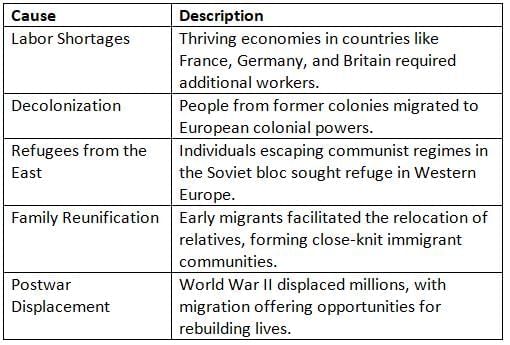Migrations within and to Europe Since 1945 Chapter Notes | AP European History - Grade 9 PDF Download
| Table of contents |

|
| Introduction |

|
| Migration During Postwar Recovery (1950s–1960s) |

|
| Backlash and Nationalist Responses (1970s–Present) |

|
| Religious Change in European Society |

|
Introduction
The decades after World War II transformed Europe through massive migration driven by economic recovery and political upheaval. Migrants from former colonies, refugees fleeing conflict, and those seeking opportunity reshaped the continent’s demographic and cultural landscape. This chapter notes explores the causes, cultural impacts, and political reactions to these migrations, highlighting ongoing debates over identity, religion, and social cohesion.
Migration During Postwar Recovery (1950s–1960s)
Causes of Increased Immigration
The economic revival of the 1950s and 1960s in Europe created labor shortages, prompting Western and Central European nations to encourage immigration, particularly from former colonies in Africa, Asia, and the Mediterranean, to meet the demands of growing industries and urban centers.
Key Idea: Economic growth and political turmoil turned Europe into a major destination for global migration following World War II.
Cultural and Religious Impact
- The arrival of immigrants introduced diverse religions, languages, and traditions, altering Europe’s cultural identity.
- Significant Muslim populations emerged in cities such as Paris, Berlin, and London, sparking debates about secularism, integration, and national identity.
- Meanwhile, secularization grew in Western Europe, with younger generations increasingly distancing themselves from organized religion.
Backlash and Nationalist Responses (1970s–Present)
Economic Downturn and Changing Sentiment
The economic slowdown of the 1970s brought rising unemployment and social unease. Immigrants, previously welcomed as essential workers, were increasingly viewed as economic burdens or cultural outsiders, leading to growing xenophobia and support for far-right political groups.
- French National Front (FN): Established in 1972, the FN gained traction by attributing economic and social challenges to immigrants, advocating for cultural nationalism and stricter immigration and asylum policies.
- Austrian Freedom Party (FPÖ): Founded in 1956, it became more vocal against immigration in the 1980s and 1990s, promoting Euroskepticism and facing criticism for xenophobic and anti-Semitic rhetoric.
Key Idea: Declining economic optimism led to immigrants being scapegoated, boosting the rise of far-right nationalist movements.
Continued Migration and Ongoing Debate
Migration persisted beyond the 1970s, growing in scope:
- Civil conflicts and authoritarian regimes in the Middle East and Africa drove waves of asylum seekers.
- EU expansion enabled millions of Eastern Europeans to migrate westward for better economic opportunities.
- Globalization and affordable travel facilitated both legal and undocumented migration.
While many immigrants integrated successfully, tensions persisted over national identity, social unity, and multiculturalism. Debates over issues like headscarves, religious education, and urban segregation influenced policy and political discourse.
Religious Change in European Society
Migration transformed Europe’s religious landscape:
- Islam emerged as the second-largest religion in nations like France, Germany, and the UK.
- Christianity saw declining participation, particularly in Western Europe.
- Secularism became more prevalent in public institutions, such as schools and courts.
These changes challenged traditional notions of “European Identity,” sparking legal and cultural disputes over religious symbols, public expression, and citizenship.
Conclusion
Post-World War II migration profoundly reshaped Europe. Economic recovery created demand, while decolonization and Cold War conflicts supplied waves of migrants. The result was a more diverse yet polarized continent, with ongoing debates over political polarization, religious tensions, and national identity shaping modern European society.
Key Terms
- Africa: The second-largest continent, known for its cultural diversity and historical significance, influencing global migration patterns, particularly to Europe post-1945.
- Anti-immigration Policies: Laws restricting immigration, often driven by concerns over security, culture, and economics, shaping Europe’s response to post-1945 migration.
- Asia: The largest continent, with diverse cultures and histories, contributing significantly to European migration patterns through colonial and economic ties.
- Austrian Freedom Party: A right-wing Austrian party advocating nationalism and anti-immigration policies, gaining prominence amid post-1945 migration debates.
- Decolonization: The mid-20th-century process of colonies gaining independence, driving migration to Europe as former colonial subjects relocated.
- Euroscepticism: Criticism of the EU’s influence, often tied to immigration concerns, impacting European identity and integration debates since 1945.
- French National Front: A far-right French party, now National Rally, promoting anti-immigration and nationalist policies, influential in post-1945 migration debates.
- Labor Shortages: A lack of workers in post-war Europe’s booming economies, driving immigration from former colonies and other regions.
- Market-oriented Economy: An economic system driven by supply and demand, shaping post-war European migration by attracting workers to growing industries.
- Migration to Western and Central Europe: Post-1945 movement of people to these regions, driven by economic opportunities, political instability, and EU expansion.
- Refugees: Individuals fleeing persecution or conflict, a significant component of post-1945 European migration, reshaping demographics and policies.
- Religion in Society: The influence of religious beliefs on social structures, reshaped by migration and sparking debates over identity and integration.
- Secular European Society: The growing separation of religion from public life, accelerated by post-1945 migration and cultural diversification.
- Southern Europe: A region including Italy and Spain, shaped by post-1945 migration due to economic opportunities and proximity to Africa and the Middle East.
- Xenophobia: Fear or hostility toward foreigners, a significant issue in post-1945 Europe, fueling anti-immigration sentiment and nationalist movements.
FAQs on Migrations within and to Europe Since 1945 Chapter Notes - AP European History - Grade 9
| 1. What were the main reasons for migration to Europe during the postwar recovery period? |  |
| 2. How did backlash and nationalist responses shape migration policies in Europe from the 1970s onwards? |  |
| 3. What role did religious change play in shaping European society post-1945? |  |
| 4. What were the effects of decolonization on migration patterns to Europe? |  |
| 5. How did the economic conditions in Europe influence migration trends during the late 20th century? |  |














